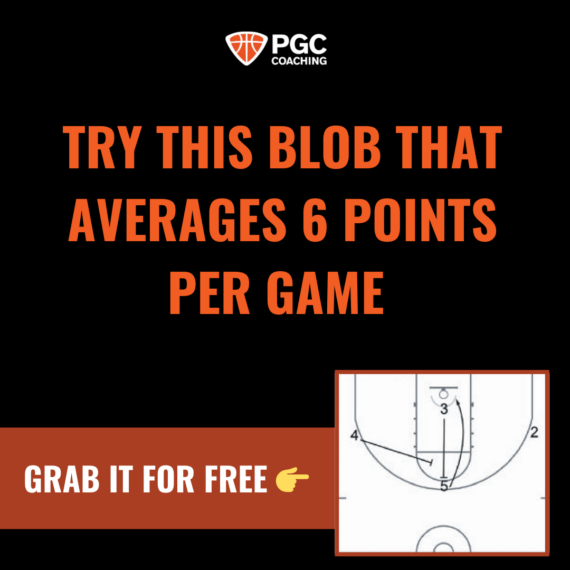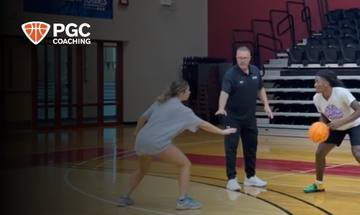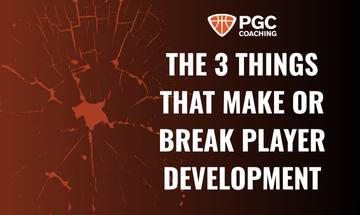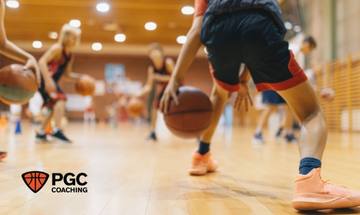7 Proven Strategies to Level Up Player Development Drills
As a coach, your number one priority is player development. And if we’re being honest, that’s harder than it sounds. Most of us have been there before—drills look sharp, players are working hard, but the results don’t show up when they matter most: in games—especially if your basketball player development drills aren’t game-like.
But there’s a way around this. At PGC, we rely on 7 strategies that ensure our teaching sticks and our players grow. And they’re not unique to us. Many of these are from Doug Lemov’s The Coach’s Guide to Teaching, a book I highly recommend.
Before we dive into the strategies, I want to make sure you have a few more resources at your fingertips. So while we’re on the subject of player development drills, here are a few more resources you may be interested in:
- How to Train Rhythm and Confidence with the One-Minute Basketball Shooting Drill
- Wrap Passing: The Basketball Passing Drill That Sharpens Footwork, Quickness, Precision
- 4-Finish Mikan Series: Build Game-Ready Finishes Around the Rim
Ok let’s dive into the 7 strategies that can transform your basketball player development drills:
1. Create a “Safe to Fail” Environment
Creating a safe-to-fail environment is one of the most underrated upgrades you can make to your basketball player development drills.
If you want your players to grow, they need permission to fail. Too often, we fall in love with order and perfection—neat lines, clean reps, no dropped balls. But clean doesn’t always mean effective. Growth happens at the edge of a player’s comfort zone, and it gets messy. So, create a space where failure is welcomed because it means players are pushing themselves.
2. Use Points of Precision
Points of precision are simple: They’re the 1 to 3 key things you’re emphasizing in any drill. It’s not about saying everything. It’s about saying the right things. Adding points of precision to your basketball player development drills sharpens execution and reinforces what matters most.
For example, when we’re teaching defense, we might use the phrase “Get to the mud.” That’s our shorthand for jumping to the gap. It brings clarity to the drill and cues players instantly on what matters most.
3. Build a Common Player Language
Common language turns your teaching into second nature. It shortens feedback, increases understanding, and keeps your practices moving. Every great program has one.
When I say “mud,” my players know exactly what I mean. We even keep a little handbook of our key offensive, defensive, and leadership terms. If you want your players to retain what you teach, start by tightening up the language you use to teach it.
A shared player vocabulary is what gives your basketball player development drills long-term retention power.
4. Diagnose and Prescribe
Too often, we treat symptoms without identifying the root problem. As a coach, your job isn’t just to run the drill, it’s to observe. Step back and ask: Where’s the breakdown?
Are they not powerful with the ball? Can’t see the floor? Struggling to make the pass? That’s diagnosing. Once you know the problem, you can prescribe the right fix. That’s where real coaching begins.
5. Give Effective Player Feedback
Here’s the truth: Most of us talk too much. Feedback should be precise, encouraging, and—when necessary—challenging. “Get to the mud, Aaron” is more effective than a 30-second explanation.
On that same note, don’t underestimate non-verbal player feedback. A high five goes a long way. It’s a silent way of saying, “You’re doing it right.” Find the balance between affirming players and raising the bar with every rep.
When used correctly, player feedback becomes a multiplier for your basketball player development drills.
6. Be NATO: Not Attached to Outcome
This one is tough. When a player does the right thing and makes a great back cut but misses the shot, are you still excited?
You should be. Because development is about the process, not the outcome. Being NATO helps your players feel safe taking the right risks, and it keeps your teaching consistent even when the scoreboard doesn’t cooperate.
7. Ensure Learning Actually Happens
Just because you taught it doesn’t mean they learned it. You’ve got to check for understanding. Ask your players: “What are we trying to accomplish here?” Their answers might surprise you—and they’ll definitely inform your next steps.
Bonus: A Game-Changing Tool for Basketball Player Development Drills
It’s not a secret that player development is the most common obstacle coaches face. And, I’ve got a solution that can help—STAGES, the Ultimate Online Basketball Player development program—this paid ‘player development coaching assistant’ works around the clock for you by:
- Pinpointing every player’s skill level instantly
- Customizing drills & tests to advance players FAST
- Tracking & accelerating progress year-round
Try our 15-day FREE trial and see firsthand how STAGES can accelerate player development and take your team’s performance to the next level.
It’s easy to check the box: we worked on shooting, rebounding, or help defense. But that’s not the goal. The goal is real, sticky, game-ready development.
Start implementing these 7 strategies in your basketball player development drills: safe to fail, points of precision, common language, diagnose and prescribe, effective feedback, NATO, and ensure learning—and you’ll begin to see the difference in your players and your program.
Let’s keep growing, Coach.
TJ
Check out all of our PGC Player Skill Development resources by clicking here.
About the Author
TJ Rosene
Coach TJ Rosene, head coach of the Emmanuel University men’s basketball team and Director of Coach Development for PGC Coaching, has spent his career shaping young athletes both on and off the court. With over 400 career wins and 12 seasons of 20+ wins, Rosene’s coaching experience is extensive and impressive. His teams have competed in six national championship games, winning three NCCAA National Championships. Under his leadership, the Lions made their NCAA Division II debut in 2018-19 and quickly captured two season titles and one tournament title, along with an appearance in the NCAA Division II Sweet 16 in 2021.
Rosene’s success expands far beyond the scoreboard. He’s been named National Coach of the Year three times and Conference Carolinas Coach of the Year twice. But for Coach Rosene, the most meaningful part of his work is the lasting impact he has on his players’ lives. As he puts it, “Coaching is a rare opportunity to shape and mold the lives of young people. It’s a privilege that I never take for granted.”
New Here?
Get coaching tips and tools like these delivered to your inbox each week!
Join the 15,000 coaches we’ve assisted…

Related Articles
How to Build Basketball Shooting Consistency: The Missing Feedback Every Coach Needs
Discover why players shoot well in practice but not in games, and how measurable shot feedback can fix it. Learn simple ways to add clarity, improve consistency, and use tools like Noah Basketball to turn practice reps into real, game-time results.
3 Basketball Player Development Strategies That Make or Break Progress
Discover the 3 keys to real basketball player development—time, clarity, and a sharp plan—with insights from Coach TJ Rosene.
5 Basketball Player Development Principles Every Basketball Coach Needs
Learn 5 key principles to run smarter, more game-like basketball workouts. Build confident, skilled players who perform when it counts.
About PGC
PGC Basketball provides intense, no-nonsense basketball training for players and coaches. Our basketball camps are designed to teach players of all positions to play smart basketball, be coaches on the court, and be leaders in practices, games and in everyday life.
We combine our unique PGC culture with a variety of teaching methods and learning environments to maximize the learning potential of those that attend our sessions. In addition to spending 6-7 hours on the court each day, lessons will be reinforced through classroom sessions and video analysis.
Our goal at PGC is to empower you with the tools to fulfill your basketball dreams, while also assisting you in experiencing the joy of the journey.
To learn more about PGC Basketball, including additional basketball training tips and videos, visit our YouTube Channel or find us on Facebook, Instagram, and Twitter.






Share This Post